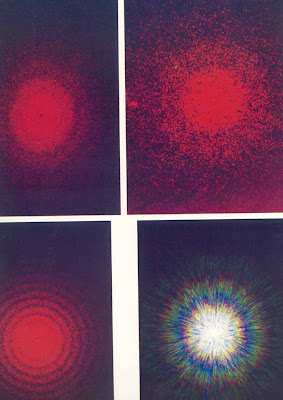

Natural phenomena are not susceptible to explanation, they can only be described. One of such phenomenon was prof C V Raman who liked to be described himself as a co-traveler of light, colour and beauty. His 65 years long deep relationship with nature during the period of 1905 to 1970 had a strong foundation on the cosmic boon of sound and light.
Fusion of light and sound with spatiotemporal modifications resulted into the emergence of natural beauty, which was always an illuminating lighthouse for scientists, artists and literary workers. Both arts and science are the keys, which can open the inner corridors of Nature's secrets. The scientists who study Nature through observations and experiments and the poet who describes the astonishing spectacle enacted in the grand theatre of the Universe are pilgrims progressing along parallel roads aiming at the realization of truth. C V Raman was on such pilgrimage.
Raman Effect is a phenomenon which is known after a person which influences maximum number of diverse fields like physics, chemistry, biology, medicine, archeology, geology, agriculture, forensic science, communication engineering, computing, laser technology etc.In fact there doesn't exist not much areas which are not influenced by Raman Effect.
Invention of various types of lasers during sixties enhanced the horizon of Raman Effect and a number of new terminologies started taking shape in the dictionary of science and technology. On this National Science Day, which remembers the discovery of RE, it, is quite appropriate to recollect Raman and his work.
C.V Raman was a recipient of Nobel Prize in 1930. In his early years, he received education at Tiruchirapalli in south India, and later passed the Indian Civil Service Examination. He started his career as a professor at the University College of Science Calcutta. He was a brilliant personality, he believed in Gandhian philosophy and the will power. One of his greatest achievements was the discovery of the 'Raman Effect' involving the scattering phenomenon of light.
C.V. Raman was born on November 7, 1888, near Tiruchirapalli in south India. He was the second child of a local schoolteacher, Chandrasekhar Iyer, and his wife Parvathi Ammal, who had eight children- five sons and three daughters. When he was four, Raman’s father took up the position of a mathematics and physics teacher in the coastal town of Vishakapatnam. The presence of a large number of books on physics, mathematics and philosophy at home aroused Raman'’ interest in science and he used to study books far in advance of his age. He was also very fond of conducting experiments with improvised apparatus at home and at school.
At the age of 11, Raman finished his matriculation and joined Presidency College on a scholarship. He passed B.A when he was only 15 years, winning gold medals in English and Physics. At college, Raman spent a considerable time studying Lord Raleigh’s scientific papers and the latest science journals. He published a paper in The Philosophical Magazine (London) in 1906 on the subject of diffraction of light bands, which he had observed while measuring the angle of a prism, using the college spectrometer. He learnt much about research from Helmholtz’s Sensations of Tone and ventured into experimental research in the college lab where no previous research had been done in physics. He also corresponded with Lord Raleigh, who was then the president of the Royal Society.
Saturday, February 28, 2009
Prof C V Raman : A Co-traveler of light, colour and beauty.
Posted by Meenu Khare at 12:00 AM 1 comments
Labels: meenu khare, Raman, Raman Effect, science is interesting
Saturday, February 21, 2009
Oscar Awards for Sci-Tech Development for Movies



The Academy’s Scientific and Technical Awards honor the men, women and companies whose discoveries and innovations have contributed in significant, outstanding and lasting ways to motion pictures. Each year’s honorees are celebrated at a formal dinner held two weeks prior to the Oscar ceremony. The Sci-Tech Awards presentation has become a highlight of the Academy Awards season.
In recognition of the critical role played by science and technology in the moviemaking process, the Academy has, almost since its inception, honored the achievements of pioneers in these fields whose work has advanced the motion picture industry.
First presented at the 4th Academy Awards ceremony in November 1931, Scientific & Technical Awards are conferred in recognition of original developments that result in significant improvements in motion picture production and exhibition.
Scientific and technical achievement is awarded on three levels: Technical Achievement Award (certificate), Scientific and Engineering Award (bronze tablet) and Academy Award of Merit (Oscar statuette).
Recent recipients of Scientific and Technical Oscars have included IMAX, for its method of filming and exhibiting large-format, wide-angle motion pictures; Avid Technology, for its non-linear editing system; and Horst Burbulla, for his invention and development of the Technocrane telescoping camera crane. Search the Academy Awards Database to find all Scientific and Technical Award winners.
Presentations of each year’s honors are made at a formal dinner held prior to the Oscar ceremony, which has become a highlight of the Academy Awards season. If one or more Scientific and Technical Academy Awards of Merit are awarded in a given year, the event is videotaped and portions are edited into the Oscar telecast.
The 1977 (50th) Awards marked the first time that the Scientific and Technical Awards ceremony became a full-fledged Awards dinner presentation. That first dinner ceremony, five days prior to the main Academy Awards ceremony, was held in the Grand Ballroom of the Beverly Hilton on March 29, 1978. Kirk Douglas and Gregory Peck hosted. Over the next decade, hosts included Christopher Reeve, Lloyd Bridges, Arnold Schwarzenegger, Janet Leigh, Macdonald Carey and other notables.
Starting with the 1978 (51st) Awards, the “Class I” Scientific and Technical Award became the Academy Award of Merit, “Class II” became the Scientific and Engineering Award and “Class III” became the Technical Achievement Award.
The practice of holding a separate Sci-Tech Awards dinner has continued ever since the 1977 Awards. Locations for the dinner ceremony have included the Beverly Hilton, Century Plaza Hotel, Regent Beverly Wilshire, Ritz-Carlton Huntington (Pasadena) and the Beverly Wilshire. Richard Dreyfuss, Helen Hunt, Charlize Theron, Jennifer Garner and Scarlett Johansson are among the hosts in recent years.
Posted by Meenu Khare at 2:53 PM 3 comments
Labels: Academy Awards, Awards ceremony, meenu khare, Oscar, Science and Technology
Interesting life of Charles Darwin


Everyone knows about Charles Darwin (Bicentenary : Feb12th,2009) and his theory of natural selection, but here is something which many of us may not be knowing.
1. Darwin Wanted to Be a Doctor, but He Couldn't Stand the Sight of Blood
Darwin attended Edinburgh University in hopes of becoming a physician like his father, but soon abandoned the idea because he couldn't stand the sight of blood. So he decided to study divinity instead and become a rural cleric, which would fit his hobby of being a naturalist just fine.
2. Darwin Once Ate an Owl
Darwin was an inquisitive man. He was curious about nature. When he saw strange animals, he often wondered what they would taste like. This is the reason why he actually ate an ‘Owl’!
3. Darwin's Nose Almost Cost Him the Voyage on the Beagle
The Captain of HMS Beagle, Robert FitzRoy, was about to embark on a survey expedition to South America, but he was afraid of the stress and loneliness of such a voyage. So FitzRoy asked his superiors for a well-educated and scientific gentleman companion to come along as an unpaid naturalist whom he could treat as an equal. The professors at Cambridge recommended then 22-years old Charles Darwin for the trip.
Darwin and FitzRoy got together well, but later Darwin found out that he almost didn't get picked for the voyage ... on account of the shape of his nose!
4. Best Birthday Gift Ever: a Mountain!
For Darwin's 25th birthday on February 12, 1834, Captain FitzRoy named a mountain after him. Yes, Mount Darwin. It is the highest peak in Tierra del Fuego.
5. The Full Title of "On The Origin of Species"
You probably know that Darwin's most famous work, outlining his theory of evolution, is On the Origin of Species but what most people don't know is the full title: On the Origin of Species by means of Natural Selection, or the Preservation of Favored Races in the Struggle for Life. It was published in 1859, twenty years after his epic voyage. In the 6th edition, the title was changed to The Origin of Species.
6. Darwin Didn't Invent the Phrase "Survival of the Fittest"
That was Herbert Spencer, a philosopher and contemporary of Charles Darwin. After reading Darwin's On the Origin of Species, Spencer wrote Principles of Biology in 1864. He coined the phrase "survival of the fittest" and extended Darwin's theory of natural selection into the realm of sociology, ethics, and economics.
Darwin himself used the phrase in his 5th edition of The Origin and gave full credit to Spencer.
7. Darwin Married His First Cousin
Darwin was a logical man, and he approached the important issue of marriage like he would any problem. In The Correspondence of Charles Darwin, Darwin made careful pro and con list of marriage to his first cousin, Emma Wedgwood.
It is ironic that the man who gave rise to the importance of genetics in natural selection chose to marry his first cousin (Darwin wasn't alone in this - Einstein also married his cousin), but one thing is for sure: Darwin cleverly avoided adding more relatives to visit!
8. How Darwin Lost His Faith in Christianity
Darwin was actually quite a religious fellow but he lost his faith when his daughter Annie caught scarlet fever and died at the age of 10. He wrote "We have lost the joy of the household, and the solace of our old age ... Oh that she could now know how deeply, how tenderly we do still & and shall ever love her dear joyous face."
9. Darwin was a Backgammon Fiend
After his return from South America, Darwin developed a life-long illness that left him severely debilitated or bed-ridden for long periods of time. Darwin consulted with more than 20 doctors, but the cause of his disease was never discovered.
10. Church of England Finally Apologized to Darwin
When Darwin's work on the theory of evolution came out, the church attacked him vociferously. Now, 126 years after his death, The Church of England has apologized to Darwin:
Charles Darwin: 200 years from your birth, the Church of England owes you an apology for misunderstanding you and, by getting our first reaction wrong, encouraging others to misunderstand you still. Good religion needs to work constructively with good science – and I dare to suggest that the opposite may be true as well.
Posted by Meenu Khare at 12:00 AM 6 comments
Labels: Charles Darwin, Interesting Facts, meenu khare, Mount Darwin, Origin of Species, science is interesting, Survival of the Fittest
Wednesday, February 18, 2009
Papercraft Weapons
Papercraft is an evolved form of the ancient art of Japanese origami. While with origami, no glue is used, you are free to use glue and other means of holding the paper or card stock together with papercraft.
Paper Wars is an English art exhibit that features some very well done papercraft weapons. Among the classic cold-war type weapons, they have designed an AK-47, Mills Bomb, MP5, Oerlikon 35mm, and an Uzi. Counterstrike fans should know some of those guns well.









Courtesy:Funlok.com
Posted by Meenu Khare at 11:30 AM 1 comments
Labels: entertaining, meenu khare, Papercraft Weapons, pictures, science is interesting
Monday, February 16, 2009
Allergy




What is Allergy?
Have you ever started wheezing after spending too much time outdoors especially in traffic? Or suddenly sneezed when breathing in the fumes released by a factory? Or felt your tongue swell up after eating prawns? Or got a red angry rash on your skin for no apparent reason? Do you often suffer from headaches, nausea, or fatigue? If your answer is yes to any one or more of these questions, then you may be suffering from an allergy.
DEFINITION
The word ‘allergy’ comes from two Greek words, which mean ‘altered reaction’. In case of a living organism’s body, it is the hyper-sensitivity of the immune system to allergens (allergy causing substances). And this makes our immune system attack the body itself! Allergies can be of various types – inhalant, food, chemical, skin, and multiple – and their symptoms can vary from a mild rash to an asthma attack. Some reactions can even lead to death. So are we incapable of taking in these aliens? No, we are not.
ALLERGIC FIGHT
Nature has given many weapons to our bodies against the invasion of unwanted alien substances. These include our nose hair, earwax, skin, and mucous. But the most important among these is our immune system, which produces white blood cells (WBC) to fight infection and diseases. But, the enemy is getting stronger day by day. The increasing number of irritants present in the environment is slowly overpowering our bodies’ natural defenses.
CHANGING ENVIRONMENT
Allergies have existed from time immemorial. However, they were never as widespread or severe as they are today. Normally, natural allergens like pollen cause seasonal allergies, which run their course and die out. But according to most doctors, allergies are no more seasonal. They have become perennial. And this is due to the influence of ‘unnatural’ allergens – like fumes of diesel exhausts, volatile organic solvents (VOC), pesticides, and tobacco smoke.
These health hazards are ever present around us, and we are completely unaware of their threat. Rapid industrialization and an increased dependence on products with high chemical content have wrecked havoc on our environment and in turn, our bodies. Contamination of food and water with pesticides and fertilizers, addiction to processed food items and additives, dust, smog, and constant exposure to VOCs from regularly used substances like plastics, adhesives and paints are all harming our bodies. And our defense systems cannot keep pace with these rapid changes in the environment.
Moreover, it is a vicious cycle. Increase in allergies means reduced efficiency of the immune system, which in turn means that the body becomes more susceptible to diseases.
BATTLE STRATEGY
In the battle against dirt, the central vacuum cleaner is the most high-tech weapon in the arsenal...
we should avoid the use of harmful pesticides and fertilizers, chemical additives in food, use of diesel in vehicles, and smoking in public areas also fall in this danger zone.
Yoga and Pranayam may also help fighting it.
In a nutshell, we must deter the degradation of our environment and work towards cleaning it up.
Posted by Meenu Khare at 1:02 AM 2 comments
Labels: allergens, allergy, BATTLE ALLERGY, entertaining, environment, health hazards, immune system, meenu khare, plastics, science is interesting, VOCs
Saturday, February 14, 2009
Einstein's Valentine
Posted by Meenu Khare at 12:48 AM 1 comments
Labels: cartoon.valentine, Einstein, entertaining, meenu khare, science is interesting, valentine Day
Saturday, February 7, 2009
SMILE: 25 YEARS LATER
Posted by Meenu Khare at 8:40 AM 5 comments
Labels: cartoon, e-Toon, entertaining, God, heaven, intelligence, laugh.smile, meenu khare, mother, saint, smile, son, student, teacher







